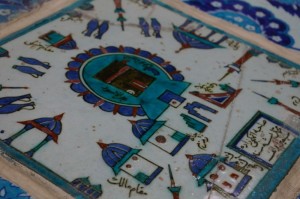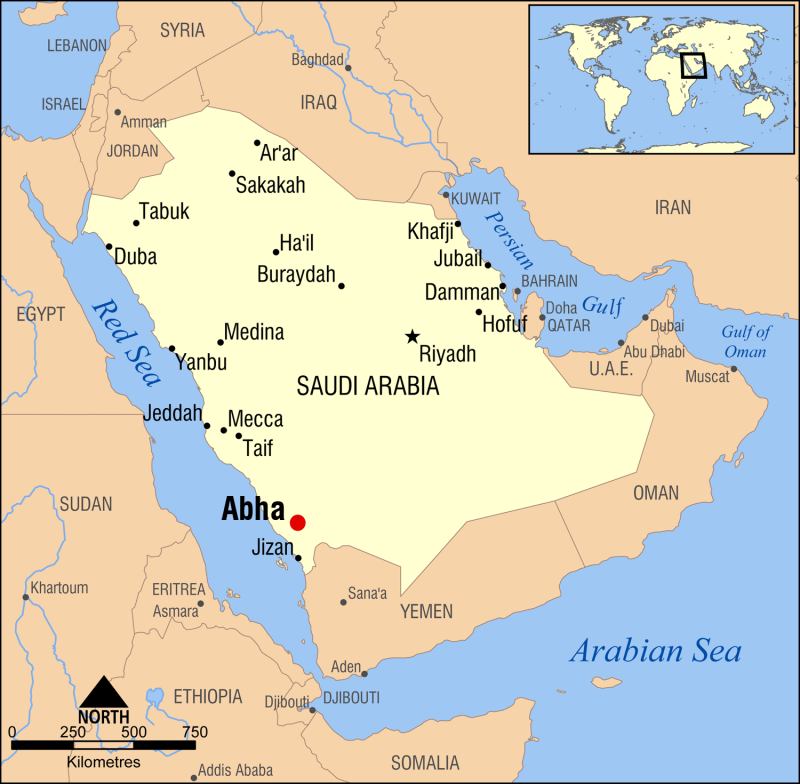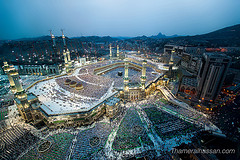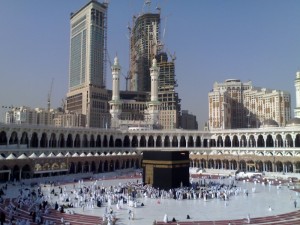Mecca
Created by Leo Rudawsky, Michael Tsamasiros, and Zoe Cottom. Published December 4th, 2013.
History
Though the early history of Mecca is fairly unknown, most people believe the origins of Mecca go back to the original Kabba, which was constructed by Adam. His descendant Abraham rebuilt the Kabba after the Great Flood, which is thought to encompass the perfection of his faith and for this reason the city is often referred to as the “City of Abraham” (Lings, 2004).

A tile at the Rüstem Pasha mosque depicting the Kabba and its sacred ground – Bakkah – as the epicenter of Mecca (Kirby). 
In ancient times, Mecca was referred to as Baca, or Bakkah, which is mentioned in sura 3, ayah 96 of the Koran as the first place of worship. Bakkah today, according to most scholars, actually refers to specifically the Ka’bah and its immediate worshipping site around it, instead of Mecca as a whole.
A key part in Mecca’s history is the birthplace of Mohammed and the site of his first Revelation, in the nearby cave of Hira. Furthermore, many more important events in Islamic history occurred in Mecca, such as the pagan tribes exiling Mohammed and the Treaty of Hudaybiyyah.
The Holiest City
The Encyclopedia Britannica states that Mecca, or Makkah, is a city located in western Saudi Arabia. As the birthplace to the prophet Mohammed, Mecca is the holiest city of Islam. It is also the city to which practicing Muslims face for their daily prayers. Mecca is home to the Kabba, which according to Islamic tradition, was built by Abraham and Ishmael as the house of God. It has since been destroyed and rebuilt numerous times. The Grand Mosque was built surrounding the Kabba as a means to protect it.
Mecca was originally ruled by Shi’ite descendants of Mohammed, but many religious conflicts and political turmoil have ensued since the 1900s (Abdo & Glubb, 2012). As stated by David Long, author of The Hajj Today: A Survey of the Contemporary Pilgrimage to Makkah, non-Muslims are not allowed to enter the city because of its importance in Islam. In addition, Mecca hosts one of the largest public exercises each year- the Hajj. The hajj is the Great Pilgrimage for Muslims. (Long, 1979).
Mecca Today
Modern day Mecca has gone through some changes over the years, but the city still has the same purpose. It is a place for the Muslim people to come together and worship. Muslim people who can afford it are required to go on a pilgrimage to Mecca at least once in their life, but in the modern day, that is not the only reason for Muslims to visit Mecca. Religion was and always will be the most important thing to the city of Mecca, however in modern times, Mecca has also taken tourism seriously. The hajj pilgrimage brings in between two and three million people every year, and it is a modern spectacle. With so many people coming every year, the city of Mecca has gone through some changes to better accommodate their visitors. (Peer, 2012)
They recently completed the construction of the Abraj Al Bait Towers, which consist of a 20 story shopping mall, and five star hotel, and a large prayer room with a capacity of 10,000 people to accommodate those visiting the Kaaba, which happens to be right across the street.
Although Mecca has made improvements to become a desirable place to visit year round, religion is still very serious in the city, which is why to this day, non-Muslims are still not permitted to enter the city. There are highway signs and roadblocks to prevent non-Muslims from entering the city, because it is believed that the city should be for Muslims believers to find peace and refuge, and the ban is to keep the sanctity of the holy city.
References
Abdo, A., & Glubb, S. B. (2012, Oct 31). Encyclopedia Britannica.
Kirby, A. (n.d.) Kaaba Tile. Tile at Rustem Pasha Mosque. Rustem Pasha Mosque, Mecca.
Lings, M. (2004). Mecca: From Before Genesis until Now. Cambridge: Archetype.
Long, D. E. (1979). The Hajj Today: A Survey of the Contemporary Pilgrimage to Makkah. Albany, NY: State University of New
York Press, The Middle East Institute, Georgetown University Center for Contemporary Arab Studies .
Peer, B. (2012) A Reporter at Large, “Modern Mecca,” The New Yorker







